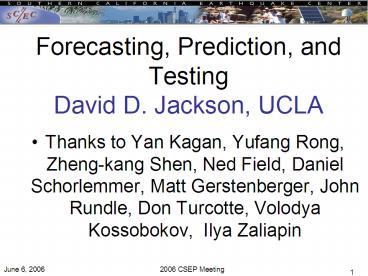Forecasting, Prediction, and Testing David D. Jackson, UCLA - PowerPoint PPT Presentation
1 / 15
Title:
Forecasting, Prediction, and Testing David D. Jackson, UCLA
Description:
But 'earthquake on segment' is subjective. ... The next earthquake in a given region and magnitude interval will not be before ... – PowerPoint PPT presentation
Number of Views:76
Avg rating:3.0/5.0
Title: Forecasting, Prediction, and Testing David D. Jackson, UCLA
1
Forecasting, Prediction, and TestingDavid D.
Jackson, UCLA
- Thanks to Yan Kagan, Yufang Rong, Zheng-kang
Shen, Ned Field, Daniel Schorlemmer, Matt
Gerstenberger, John Rundle, Don Turcotte, Volodya
Kossobokov, Ilya Zaliapin
2
Definitions
- Forecast specification of the probability per
unit area, magnitude, time, focal mechanism,
etc. - Prediction special case of forecasting in which
the probability in some region is much higher
than normal, and high enough to justify
exceptional . - Notes a prediction must be temporary it also
requires a definition of normal (i.e., a null
hypothesis).
3
Why forecast and test
- Test hypotheses of earthquake physics
- Quasiperiodic characteristic earthquakes
- Magnitudes limited by fault geometry
- Moment balance (tectonic in seismic out)
- Earthquake rate proportional to stress rate
- Inform decisions about earthquake risk
- Facility locations, building codes, insurance
rates, retrofit, etc. - Inspire envy
4
Some testable statements
- At least one event will occur within given
region, time interval, and magnitude interval
with probability p. - For many small intervals, this is RELM type
forecast - Replace region by segment and have WG88 type
forecast. But earthquake on segment is
subjective. - N events will occur within given region, time
interval, and magnitude interval with probability
p(N). - The largest event in given region and time
interval will be m, with probability p(m). My
recommendation for a usable and stable forecast.
- If an event occurs in region 1, time interval 1,
and magnitude interval 1, it will be in the
included region 2, time interval 2, and magnitude
interval 2 with probability p. (KB type
forecast) - The next earthquake in a given region and
magnitude interval will not be before time t with
probability p(t). Replace region by segment and
have WG88 type forecast.
5
What we can and cant do now
- Can
- Forecast 90 of quakes in 10 of area.
- Predict aftershocks
- Forecast mag-freq relationship for N(m)10.
- Maybe can
- Forecast earthquake rate from deformation rate.
- Establish earthquake rate for normal
conditions - Forecast Mmax
- Cant
- Predict times of individual earthquakes
6
(No Transcript)
7
(No Transcript)
8
Likelihood Testing
- Simulate catalogs using L(lat,lon)
- Compute log likelihood function for observed and
simulated catalogs - Sort L values in increasing order, plot order vs
L.
9
Practical problems in testing
- Many users many criteria
- Earthquakes not independent
- Testing should be rigorous, but also feel
good. - Data on rupture lengths, endpoints of rupture,
slip distribution, etc., not formalized
10
(No Transcript)
11
(No Transcript)
12
Ten-year Prospective Test of Seismic Gap and Null
(Poissonian Smoothed Seismicity) models
Rank zones by decreasing probability of
characteristic earthquake accumulate area,
predicted earthquake number, and actual
earthquake number.
13
Properties of test methods
- Likelihood ratio test
- Includes absolute rates
- Useful for marked point process lat, lon, mag,
etc. - As used, assumes independent events
- Adaptable to time varying forecasts
- Could use declustered catalog
- Gives scalar score
- Likelihood ratio test on largest event in zone,
time interval - Reduces effect of dependent events
- May respond to long-term users investors,
planners - Molchan diagram
- Based on relative rates, as normally used
- Needs a scalar measure to reject a hypothesis
- Not convenient for marked point processes need
to commit to magnitude threshold, e.g. - Does not avoid problem of dependent events
14
Testing scheme for elements of risk model
15
Conclusions
- Many users Many criteria for optimality
- Absolute rate vs. relative rate
- Short time vs. long time
- Big events vs. smaller ones
- Biggest problem is interdependence of quakes
- Long term users want stability unconditional
probabilities - Scientists care about interactions conditional
probabilities - Solutions to interdependence
- Decluster catalog needs model
- Test using conditional probabilities updated
automatically - Test only largest earthquake in zone.































